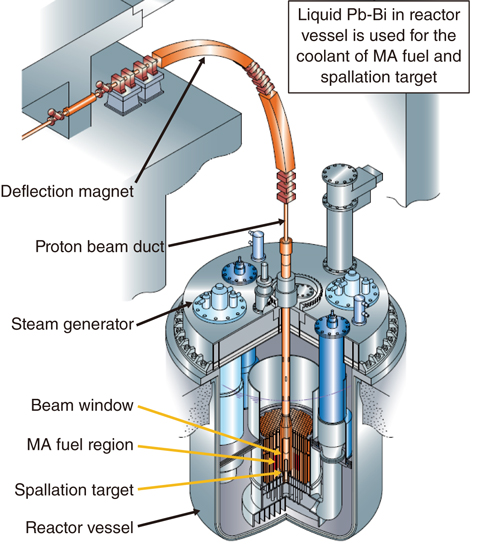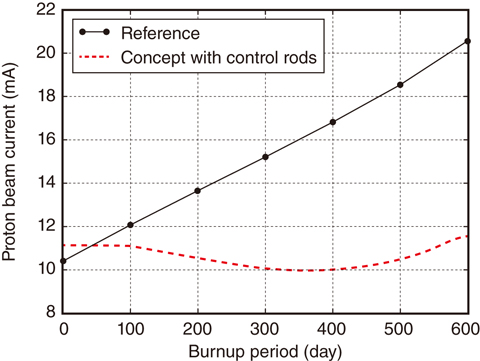
Fig.4-22 Conceptual diagram of the ADS

Fig.4-23 Change of the proton beam current for ADS with control rods
To reduce the burden of geological disposal of the high-level waste (HLW) discharged from nuclear power plants, transmutation technology capable of transmuting long-lived nuclides into short-lived ones, has been investigated. It is expected that this technology can reduce the area of repository sites for HLW and the time at which the radioactivity of HLW decays to that of natural uranium from the order of tens of thousands of years to the order of a few hundred years. We have performed research and development on an accelerator-driven system (ADS) to transmute minor actinides (MAs) separated from the HLW.
The ADS is a hybrid system comprising an accelerator and a subcritical core with MA fuel (Fig.4-22). Although the ADS can efficiently transmute the MA, there are many inherent issues. One important issue is the design of a beam window that acts as a boundary of the accelerator and the subcritical core.
The important factor affecting the design of this window is heat generation by the proton beam. To maintain the subcritical core power at a constant level, it is necessary to increase the proton beam current to compensate for the decrease in the effective multiplication factor during the burnup cycle. The investigation of a new ADS concept with a subcritical adjustment mechanism began to prevent the increase of the proton beam current. In this study, a control rod used often in an existing nuclear power plant was employed as the subcritical adjustment mechanism. However, we lacked an ADS neutronics analysis tool to treat large absorbers such as the control rod because simple RZ-calculation geometries had been employed in the design of ADS neutronics in the past.
The ADS3D code system was developed on MARBLE, a next generation reactor analysis code system developed by JAEA to achieve ADS neutronics calculation with the control rod. The ADS3D code system was able to calculate the transportation of protons and neutrons, the burn-up calculation, and the fuel exchange in a three-dimensional calculation model.
Fig.4-23 shows the calculation results for the ADS concept with the control rod using ADS3D. In the reference case, the proton beam current at the end of the cycle was 20 mA, so a heat generation condition of 20 mA was employed for the design of the beam window. By installing the control rod, it was observed that the maximum proton beam current was less than 12 mA during the burnup cycle. A decrease of 40% in the proton beam current was achieved. Since the heat generation condition is mitigated by the installation of the control rod, a new beam window concept will be investigated.